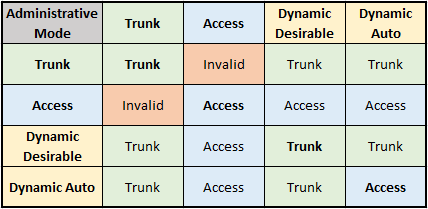Trunk
- A trunk interface is a single, physical interface that can route traffic to multiple VLANS
- Functions at Layer 2
- There are four Administrative Modes that can be configured on a switch interface
- access
- A statically configured access port will only serve a single data VLAN
- It can be configured to also serve a voice VLAN
- trunk
- Statically configured to serve as a trunk port, and will never become an access port
- DTP is enabled on the interface unless it is disabled with
switchport nonegotiate
- DTP frames will not be sent, which can prevent an attack from configuring a trunk and VLAN Hopping
- If connected to an access port, it will not form a link
- dynamic auto
- Configured with DTP to passively form a trunk if it is connected to a dynamic desirable or trunk port
- However, it will not initiate a transition to a trunk, and will remain an access port if connected to a dynamic auto or access port
- dynamic desirable
- Configured with DTP to actively forma trunk if it is connected to a dynamic desirable, dynamic auto, or trunk port
- If connected to an access port, it will remain an access port

Source: Original
OSI or TCP/IP Layer
CCNA Exam Topic
#extop-2-2
Contributors
Sources
